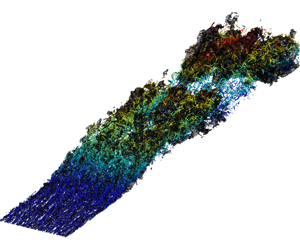Crossref Citations
This article has been cited by the following publications. This list is generated based on data provided by
Crossref.
Yin, Guang
and
Ong, Muk Chen
2020.
On the wake flow behind a sphere in a pipe flow at low Reynolds numbers.
Physics of Fluids,
Vol. 32,
Issue. 10,
Le Floc'h, Arnaud
Weiss, Julien
Mohammed-Taifour, Abdelouahab
and
Dufresne, Louis
2020.
Measurements of pressure and velocity fluctuations in a family of turbulent separation bubbles.
Journal of Fluid Mechanics,
Vol. 902,
Issue. ,
Fang, Xingjun
and
Tachie, Mark F.
2020.
Tracking the flapping motion of flow separation using pointwise measurement.
Physics of Fluids,
Vol. 32,
Issue. 3,
Wu, Wen
Mittal, Rajat
and
Meneveau, Charles
2020.
Total mechanical energy transport lines and attractors in separating turbulent boundary layers.
Physical Review Fluids,
Vol. 5,
Issue. 1,
Ben Hassan Saïdi, Ismaïl
Fournier, Guillaume
and
Tenaud, Christian
2020.
On the Behaviour of High-Order One-Step Monotonicity-Preserving Scheme for Direct Numerical Simulation of Shocked Turbulent Flows.
International Journal of Computational Fluid Dynamics,
Vol. 34,
Issue. 9,
p.
671.
Park, Junshin
Ha, Sanghyun
and
You, Donghyun
2021.
On the unsteady Reynolds-averaged Navier–Stokes capability of simulating turbulent boundary layers under unsteady adverse pressure gradients.
Physics of Fluids,
Vol. 33,
Issue. 6,
Weiss, Julien
Little, Jesse C.
Threadgill, James A.
and
Gross, Andreas
2021.
Low-Frequency Unsteadiness in Pressure-Induced Separation Bubbles.
Klevs, M.
Birjukovs, M.
Zvejnieks, P.
and
Jakovics, A.
2021.
Dynamic mode decomposition of magnetohydrodynamic bubble chain flow in a rectangular vessel.
Physics of Fluids,
Vol. 33,
Issue. 8,
Mohammed-Taifour, Abdelouahab
and
Weiss, Julien
2021.
Periodic forcing of a large turbulent separation bubble.
Journal of Fluid Mechanics,
Vol. 915,
Issue. ,
Wang, Sen
and
Ghaemi, Sina
2022.
Unsteady motions in the turbulent separation bubble of a two-dimensional wing.
Journal of Fluid Mechanics,
Vol. 948,
Issue. ,
Serta Fraga, Vinicius
Yin, Guang
and
Ong, Muk Chen
2022.
Three-dimensional numerical simulations and proper orthogonal decomposition analysis of flow over different bottom-mounted ribs.
Ships and Offshore Structures,
Vol. 17,
Issue. 4,
p.
792.
Li, Nan
2022.
Reciprocating and flapping motions of unstart shock in a scramjet isolator.
Physics of Fluids,
Vol. 34,
Issue. 1,
Li, Nan
2022.
Response of shock train to fluctuating angle of attack in a scramjet inlet-isolator.
Acta Astronautica,
Vol. 190,
Issue. ,
p.
430.
Wu, Wen
Meneveau, Charles
Mittal, Rajat
Padovan, Alberto
Rowley, Clarence W.
and
Cattafesta, Louis
2022.
Response of a turbulent separation bubble to zero-net-mass-flux jet perturbations.
Physical Review Fluids,
Vol. 7,
Issue. 8,
Yin, Guang
Janocha, Marek Jan
and
Ong, Muk Chen
2022.
Estimation of Hydrodynamic Forces on Cylinders Undergoing Flow-Induced Vibrations Based on Modal Analysis.
Journal of Offshore Mechanics and Arctic Engineering,
Vol. 144,
Issue. 6,
Park, Danah
Liu, Jessie
and
Mani, Ali
2022.
Direct measurement of the eddy viscosity tensor in a canonical separated flow: What is the upper bound of accuracy for local Reynolds stress models?.
Vaquero, Jaime
Renard, Nicolas
and
Deck, Sébastien
2022.
Outer layer turbulence dynamics in a high-Reynolds-number boundary layer up to recovering from mild separation.
Journal of Fluid Mechanics,
Vol. 942,
Issue. ,
Li, Cruz Y.
Chen, Zengshun
Tse, Tim K. T.
Weerasuriya, Asiri Umenga
Zhang, Xuelin
Fu, Yunfei
and
Lin, Xisheng
2022.
A parametric and feasibility study for data sampling of the dynamic mode decomposition: Spectral insights and further explorations.
Physics of Fluids,
Vol. 34,
Issue. 3,
Manohar, Kevin H.
Williams, Owen
Martinuzzi, Robert J.
and
Morton, Chris
2023.
Temporal super-resolution using smart sensors for turbulent separated flows.
Experiments in Fluids,
Vol. 64,
Issue. 5,
Savino, Benjamin S.
Yeom, Taiho
and
Wu, Wen
2023.
Numerical Study of Turbulent Characteristics behind Novel Vortex Generating Structures.



